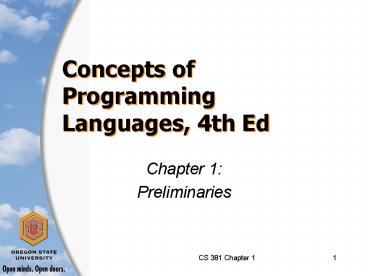Concepts of Programming Languages, 4th Ed - PowerPoint PPT Presentation
1 / 13
Title:
Concepts of Programming Languages, 4th Ed
Description:
worry about machine efficiency - Late 1960s: People efficiency became important; ... Translate high-level program to machine code - Slow translation - Fast execution ... – PowerPoint PPT presentation
Number of Views:140
Avg rating:3.0/5.0
Title: Concepts of Programming Languages, 4th Ed
1
Concepts of Programming Languages, 4th Ed
- Chapter 1
- Preliminaries
2
Reasons to study concepts of Programming Languages
- 1. Increased capacity to express programming
- concepts
- 2. Improved background for choosing
appropriate - languages
- 3. Increased ability to learn new languages
- 4. Understanding the significance of
implementation - 5. Increased ability to design new languages
- 6. Overall advancement of computing
3
Programming Domains
- Scientific applications
- Business applications
- Artificial intelligence
- Systems programming
- Scripting languages
- Special purpose languages
4
Language Evaluation Criteria1. Readability
- The most important criterium
- Factors
- - Overall simplicity
- Too many features is bad
- Multiplicity of features is bad
- - Orthogonality
- Makes the language easy to learn and read
- Meaning is context independent
- - Control statements
- - Data type and structures
- - Syntax considerations
5
Language Evaluation Criteria2. Writability
- Factors
- - Simplicity and orthogonality
- - Support for abstraction
- - Expressivity
6
Language Evaluation Criteria3. Reliability
- Factors
- - Type checking
- - Exception handling
- - Aliasing
- - Readability and writability
7
Language Evaluation Criteria4. Cost
- - Categories
- - Programmer training
- - Software creation
- - Compilation
- - Execution
- - Compiler cost
- - Poor reliability
- - Maintenance
8
Language Evaluation Criteria5. Other Criteria
- portability
- generality
- well-definedness
9
Primary influences on language design
- 1. Computer architecture
- - We use imperative languages, at least in
part, - because we use von Neumann machines
- 2. Programming methodologies
- - 1950s and early 1960s Simple applications
- worry about machine efficiency
- - Late 1960s People efficiency became
important - readability, better control structures
- - Late 1970s Data abstraction
- - Middle 1980s Object-oriented programming
10
Language Categories
- Imperative
- Functional
- Logic
- Object-oriented (closely related to imperative)
11
Language Design Trade-Offs
- Reliability versus cost of execution
- Writability versus readability
- Flexibility versus safety
12
Implementation Methods
- 1. Compilation
- - Translate high-level program to machine
code - - Slow translation
- - Fast execution
- 2. Pure interpretation
- - No translation
- - Slow execution
- - Becoming rare
- 3. Hybrid implementation systems
- - Small translation cost
- - Medium execution speed
13
Programming Environments
- -The collection of tools used in software
- development
- 1. UNIX
- - An old operating system and tool
collection - 2. Borland C
- - A PC environment for C and C
- 3. Smalltalk
- - A language processor/environment
- 4. Microsoft Visual C
- - A large, complex visual environment































